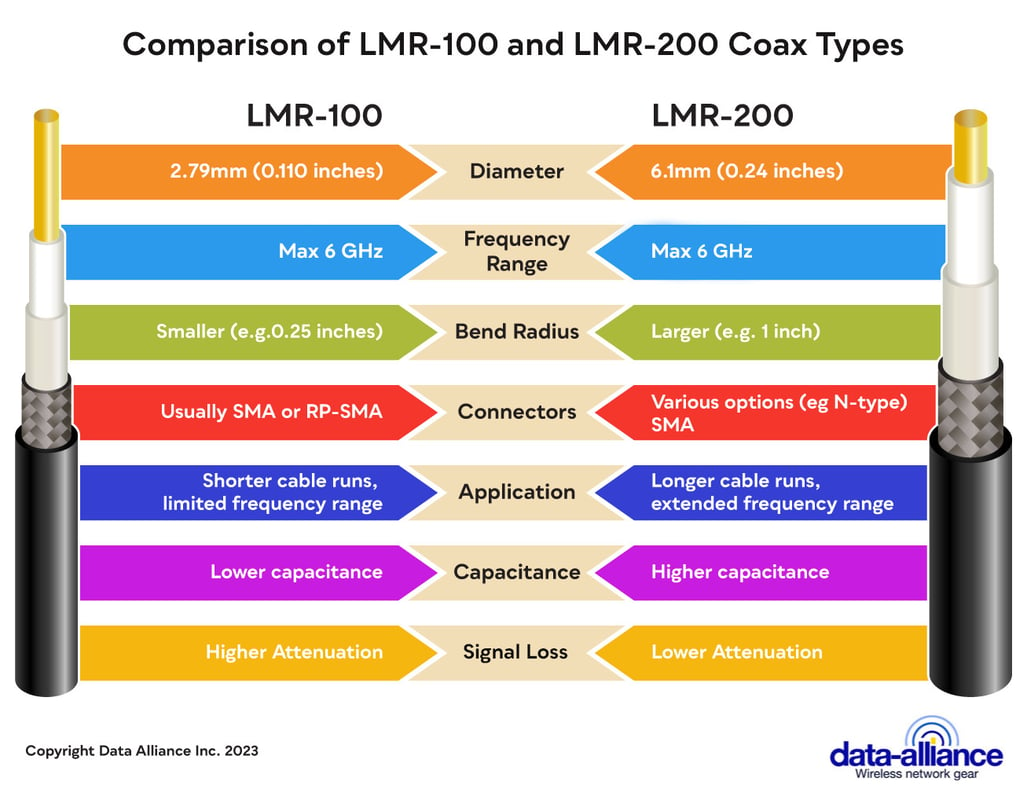RP-SMA to N
N-Type to RP-SMA Antenna Cables: Coax Types, Specs, Applications
Double-Shielded Coaxial Cable Types Used in RP-SMA to N Cables: We offer two options: LMR-100-equivalent and LMR-200 equivalent.

Compare the specifications of our double-shielded coax, to single-shielded coaxial cable types, such as these below, which have higher signal loss and are commonly used in the making of RPSMA to Type-N antenna cables:
- RG-58/U: A widely used coaxial cable, particularly known for its flexibility. It's often used in situations where the cable needs to be moved or flexed frequently.
- RG-174: A smaller diameter coax, suitable for tight spaces and applications where space is at a premium.
- RG-316: Known for its high temperature resistance and robustness, this coax is often used in high-stress environments.
Suitability for Specific IoT Applications
IoT, characterized by its interconnected devices, calls for efficient and high-performance cables. RP-SMA to N cables are particularly suited for:
- Long-Range Communication: Their low attenuation rates make them a prime choice for applications that need to transfer data over longer distances.
- Industrial IoT: Given the rugged nature and high performance, these cables can be used in environments like factories where devices need to withstand external influences.
- Smart Home Applications: They serve to connect various smart devices, ensuring a seamless data transfer.
Compatible Wireless Protocols and Technologies
RP-SMA to N cables are compatible with a myriad of wireless protocols, including but not limited to:
- Wi-Fi (across various standards)
- Zigbee
- LoRaWAN
- GSM/3G/4G/5G
Torque Ratings
An often overlooked but vital aspect is the torque rating. Generally, the recommended torque for hand tightening RP-SMA connectors is about 3-5 in-lbs, whereas for N connectors, it's around 12-15 in-lbs when using a torque wrench.
Key Features
- Low Loss: Ensures that minimal signal is lost during transmission.
- High Frequency: Suitable for applications demanding high-frequency performance.
- Durable: Made with materials to withstand various external conditions.
Materials Composition
Most RP-SMA to N cables consist of:
- Conductor: Usually made of solid or stranded tinned copper.
- Insulation: Polyethylene or PTFE.
- Shielding: Single or double shielded with either silver or tinned copper braid.
- Outer Jacket: Typically made from PVC or a fire-resistant compound.
Types and Applications
Broadly speaking, there are two types:
- Straight Cables: These are standard cables without any bends or curves.
- Right Angle Cables: These have a 90-degree bend, useful for tight spaces or specific mounting requirements.
RP-SMA to N cables have become increasingly relevant in the ever-growing world of Internet of Things (IoT) applications. These cables, specifically designed for high-frequency performance, are instrumental in bridging different devices and ensuring smooth wireless communication.







